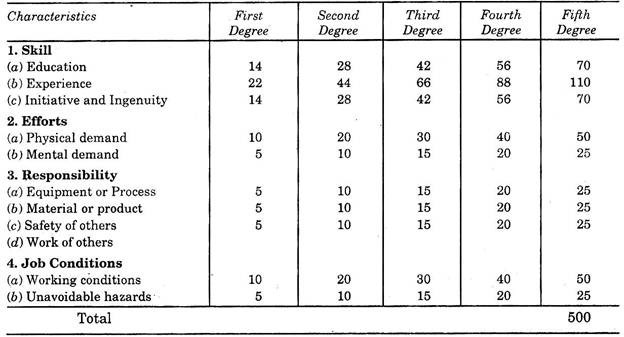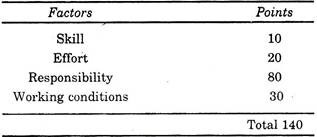After reading this article you will learn about:- 1. Meaning and Objects of Job Evaluation 2. Principles of Job Evaluation 3. Methods.
Meaning and Objects of Job Evaluation:
Job evaluation is the process of comparing jobs with other jobs in terms of wages a worker should be paid for performing the task. Thus, it is a rating of job. It can also be defined “as the procedure to determine the relative values of the job in a plant and to determine the basic wages for that job”.
Objects:
(i) Its main object is to estimate the correct wages for the work performed.
ADVERTISEMENTS:
(ii) It is a means to reduce wage imbalance in the factories.
(iii) It can be used to resolve wage disputes.
(iv) It helps in standardisation.
(v) It helps to establish a method for future promotion of workers.
Principles of Job Evaluation:
ADVERTISEMENTS:
Mr. A.L. Kress and authority in job evaluation, underlines the following principles:
1. Rate the job not man. Job requirements are definite and fixed. The man selected for doing the job may have some plus or minus points as regard to job, thus the payment should be made accordingly.
2. While doing ratings the elements selected should be minimum, but should cover the requirements of jobs.
3. The success in job rating is totally dependent upon the uniformity of understanding with regard to definitions assigned to each element and on the consistency in the selection of the degrees of those elements.
ADVERTISEMENTS:
4. The job rating plan must be easily understandable, so that there may not be any difficulty to understand the plan by workers or supervisors.
5. Foremen or supervisors must be asked to participate in the rating plan.
6. Employees must be allowed to discuss the job rating plan.
7. While discussing with supervisors and workers, consider the points only, not the money aspect of plan.
ADVERTISEMENTS:
8. Too many occupational wages should not be established.
Methods for Job Evaluation:
As already stated that the purpose of job evaluation is to compare all demands made on each worker and by means of this comparison to establish the relative worth of each job in a factory or company.
The comparison is done by two methods:
(a) Non-quantitative methods, i.e., by simple ranking or classifying the job from lowest to highest.
ADVERTISEMENTS:
This includes the following techniques:
(i) Ranking technique,
(ii) Classification method, and
(b) Quantitative methods, i.e., where point values are assigned to the various demands of a job and relative value is obtained by summing all such point values.
ADVERTISEMENTS:
This includes the following techniques:
1. Factor comparison, and
2. Point rating.
All these methods are described hereunder:
ADVERTISEMENTS:
1. Ranking method:
This is the simplest method and in this job description is arranged in the order of rank and according to the report of analysis. Job description is arranged in ascending order, beginning with the one of the minimum requirements and ending up with the one of maximum requirements.
While ranking following facts are considered:
(i) Amount of work.
(ii) Supervision need.
(iii) Responsibility required.
ADVERTISEMENTS:
(iv) Difficulty in work.
(v) Monotony of work.
(vi) Working conditions.
(vii) Knowledge and experience needed.
Advantages:
(i) It is very simple method,
ADVERTISEMENTS:
(ii) With this method, very quick results can be obtained.
Disadvantages:
(i) It does not give actual information that how much one job differs from other. It only shows higher or lower,
(ii) It gives inaccurate results, as at every time exactly same details cannot be followed for all the jobs.
The ranking method is particularly suitable for use in small organisations in establishing the relative worth of jobs. The salaries based on the ‘evaluation by ranking method’ are more reliable than that based on guess and experience. Care must be taken that ranking must not be based on salary. This method is more suitable for supervisory or similar positions.
2. Classification method:
ADVERTISEMENTS:
In this method of job evaluation, several classes or classifications of job are determined for a particular organisation, and various jobs of the company are sorted out according to this classification.
For example, in a section, there are three classifications:
(i) Class 150 includes skilled workers doing precision and die work;
(ii) Class 151 includes the workers working on lathe and milling machines,
(iii) Class 152 includes all other less skilled machine operators, such as drill, press operators, sanders etc.
After this classification, different jobs are fitted into the particular classification and relative position can be determined.
ADVERTISEMENTS:
3. Factor comparison:
In this method, job analysis is made by considering the following five main factors:
(i) Mental requirement.
(ii) Skill requirement.
(iii) Physical requirement.
(iv) Responsibility.
ADVERTISEMENTS:
(v) Working conditions.
This plan starts out with the money value paid for several important jobs. In this, at a time one job is taken and is compared with the other job, with respect to the above five main factors. Each factor is compared separately and its money value is given. For example, working condition as a factor for a key job is given, money value equal to Rs. 2.00.
The same factor, i.e., working condition for another job treated should be given some money value, now if the working conditions are much better than that for the key job, then money value to this job is of less worth, may be Rs. 1.50 or so on. It should be remembered that first of all key jobs are rated. After rating key jobs, others are rated.
When all the jobs have been rated by considering each of the above five factors separately, a wage rate for each job is fixed.
Advantages:
(i) It can be used for the calculation of unlike jobs.
(ii) It can also be applied to combinations of clerical, manual and supervisory staff.
(iii) It is not difficult to understand and use this method, even unions and workers can do the rating with some training.
Disadvantages:
(i) It is complicated method.
(ii) It is costly to introduce.
(iii) Job evaluation staff must be highly qualified and competent.
(iv) Controversy on the selection of key job.
4. Point rating:
There are so many point methods but all have a common characteristic, that is point values are assigned to each requirement.
Suppose a job is given 100 point values, then other jobs will be compared with it in all respects and they are given point values, which become the basis of job evaluation.
In this, four job factors such as skill, effort, responsibility and job condition are taken as a basis of point values and in some cases these factors are further sub-divided for more accuracy.
The following table explains the point method of job evaluation developed by the National Metal Association, America:
If we again consider the example for the job evaluation of a gatekeeper.
The evaluation can be done as follows:
140 points are equivalent to Rs. 1400 in money value, if it is assumed that 1 point is equal to Rs. 10. In this way, evaluation is done in point system.
Advantage:
Evaluation is comparatively more accurate.
Disadvantage:
Much complicated and costly method.

